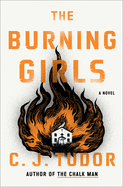
The quaint British village--the scene of many a cozy mystery--receives a chilling noir treatment in The Burning Girls, the superbly plotted fourth novel by C.J. Tudor (The Other People; The Hiding Place).
The village of Chapel Croft is known for the Sussex Martyrs: eight villagers, including two girls, burned to death during Queen Mary's purge of the Protestants. The locals are very attached to that history, making twig dolls that are burned in an annual ceremony to commemorate the purge. Rev. Jacqueline "Jack" Brooks, a widow with a 15-year-old daughter, Flo, knew about the town's history even before she was assigned to be the new vicar after the previous vicar committed suicide. A sinister atmosphere blankets the village, which, in addition to the martyrs, is still fixated on the disappearance of two teenage girls 30 years before. Jack is pulled into the dark history when she receives an exorcism box, notices lights late at night in the chapel and learns the previous vicar tried to burn down the chapel, which he called "corrupted." Jack and her daughter are close, adding to the vicar's uneasiness about Flo's friendship with troubled teenager Lucas Wrigley.
Tudor keeps the suspense high in The Burning Girls, from the bodies that keep turning up to the creepy abandoned house deep in the woods. The appealing Jack maneuvers the villagers' various secrets while trying to hide her own past, which includes an abusive childhood and an incident at a previous parish. One character's remark that "small villages have their own way" is only the start of the chilling, believable twists that ignite The Burning Girls. --Oline H. Cogdill, freelance reviewer

